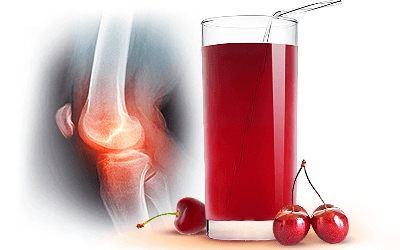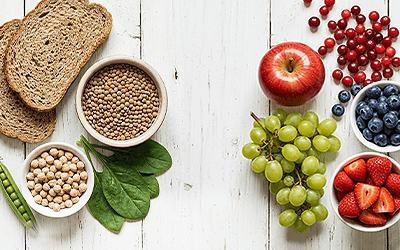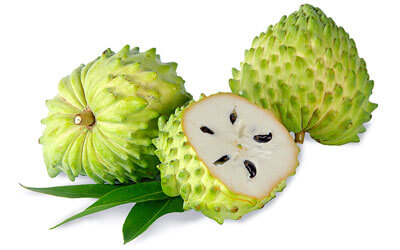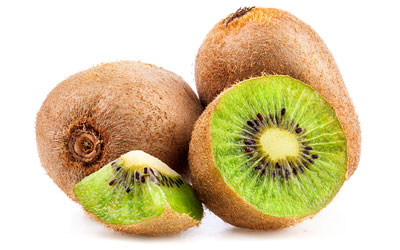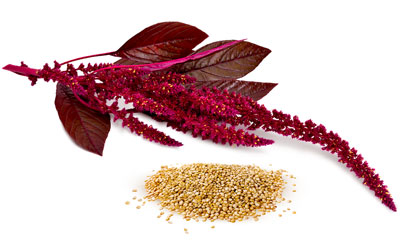Cherry fruits are widely considered tasty snacks with good nutritious value. Their origins can be traced to the Black and Caspian Sea region where Asia and Europe converge. It is thought that from there, they spread to Europe and later to the United States with the help of early colonists. Cherry trees, also valued for their high-quality timber, are now cultivated and naturalized all over the world.
Cherry Medicinal Properties
Health Benefits of Cherry
Cherries have been traditionally consumed for their rich flavor - either sweet or tart, depending on the species - and their amazing medicinal benefits, many of them validated by modern scientific research. When it comes to healthcare, cherries are most commonly used for:
Relieving pain and inflammation. Cherries have proven to be useful for treating painful health conditions, such as arthritis, lumbago, and gout.
Regulating the immune system. The consumption of cherries has been linked to improvements in endocrine balance as well as the natural regulation of sleep-wake cycles.
Other benefits of cherries are:
Detoxing the body. Cherries help the body to get rid of toxic substances that tend to accumulate in major organs, such as the gallbladder and the liver, hence improving their function.
Improving dental health. Drinking cherry juice can prevent tooth decay by reducing the accumulation of plaque.
Additionally, both tart and sweet cherries are consumed for their nutritional value. They are rich in calcium, phosphorus, magnesium, and potassium as well as vitamins A and C, among other phytonutrients with a strong antioxidant activity. These antioxidants play an important role in protecting the cells from oxidative stress and reducing the risk of heart diseases, thus preventing the development of serious illnesses.
How It Works
Cherries are rich in anthocyanidins, powerful flavonoids capable of blocking the enzymes responsible for sending “pain messages” to the cells, with analgesic effects comparable to those of ibuprofen and naproxen.1,2
While all cherries carry great amounts of antioxidants, tart cherries also offer a specific one called melatonin, which is also a hormone produced by the pineal gland and responsible for regulating sleep cycles.3 On the other hand, ripe sweet cherries contain high levels of a compound called beta-glucosidase, which is thought to reduce the likelihood of degenerative diseases.
Cherries' anthocyanidins have also been shown to inhibit the activity of xanthine oxidase, an enzyme that plays an important role in the production of uric acid, thus helping treat gout. The daily consumption of half a pound (228 g) of cherries has shown to be very effective at preventing gout attacks.4,5
Furthermore, the antioxidant activity of anthocyanidins in cherries has proven to be stronger than that of vitamin E in the same amounts, and it is very useful for alleviating muscular pain after strenuous exercise routines.
It has been suggested that daily consumption of anthocyanins may also play a role in preventing arterial stiffness and hypercholesterolemia, most likely due to their anti-inflammatory properties. However, further research is needed.
WHETHER THEY ARE SWEET OR TART, DARK CHERRIES ARE RICHER IN FLAVONOIDS THAN THEIR LIGHTER COUNTERPARTS.
Herbs like cat's claw and carambola also possess anti-inflammatory properties, whereas kiwi fruit and ginkgo can help regulate the immune system.
Cherry Side Effects and Cautions
Cherries are generally regarded as safe and are well-known for not having any negative effects or contraindications. However, caution is recommended when eating them raw since their pits could present a choking hazard.
- Medicinal action Anti-inflammatory, Immunomodulant
- Key constituents Anthocyanins, melatonin, beta-glucosidase
- Ways to use Capsules, Hot infusions/tisanes, Food, Juiced, Tincture, Dried
- Medicinal rating (5) Great value
- Safety ranking Safe

Cherry Nutrition
Sweet cherries are not only low in calories, but also a good source of fiber, which contributes with blood sugar metabolism and digestion; as well as vitamin C (ascorbic acid), necessary for immunity, iron absorption, and skin health; and potassium, which plays a key role in regulating blood pressure.
Additionally, small amounts of B-complex vitamins, important for bodily functions, are also present in cherries, as well as vitamins E (alpha-tocopherol) and K (phylloquinone), along with minerals such as magnesium, iron, phosphorus, calcium, and zinc.
One cup of sweet cherries with pits (138 g/4.9 oz.) provides 87 calories and 12% of the daily value for dietary fiber.
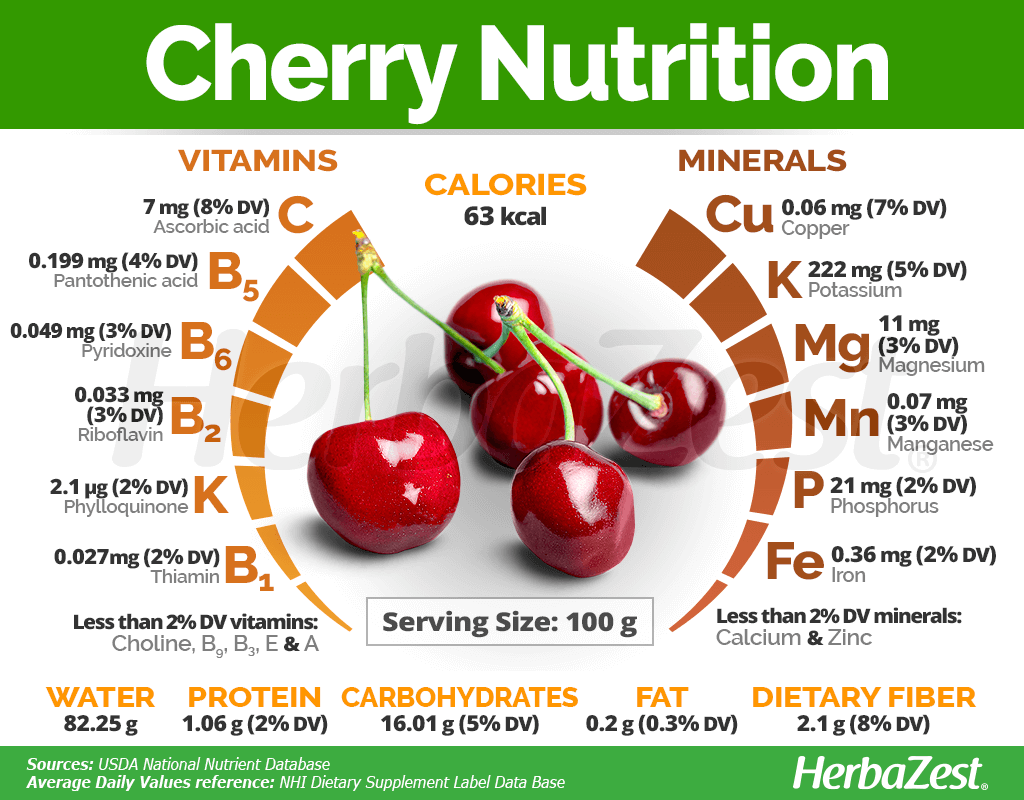
How to Consume Cherry
The best way to reap the health benefits of cherries is consuming them as food on a daily basis. However, for medicinal purposes, cherry can be taken as a supplement in different forms.
Both tart and sweet cherries are consumed chiefly raw or juiced in order to take advantage of their nutritional value.
Natural Forms
Raw. Consuming fresh cherries is the easiest way to enjoy their nutritional content.
Juiced. Home-juiced cherries retain most of their nutritional and medicinal benefits. A daily glass of tart cherry juice can help lower uric acid levels in people with gout as well as increase levels of melatonin, which can improve insomnia and lead to better sleep quality.
Dried. Dried cherries are also very popular as a healthy snack and can also be added to morning cereal for an antioxidant punch. They are commonly used to make desserts, pastries, and other confectionery like syrups, candies, and jellies.
Powder. The dried and powdered cherry bark, usually from the black or wild cherry tree (Prunus serotina), is also used to treat ailments like coughs, bronchitis, gout, diarrhea, and arthritis.
Infusion. Brewing and drinking cherry tea is a very popular way to reap some of the antioxidant benefits of these fruits.
Herbal Remedies & Supplements
Cherry supplements available on the market are typically not made from sweet cherry (Prunus avium), but rather from black cherry (Prunus serotina) or tart cherry (Prunus cerasus).
Capsules. These preparations come in standardized doses and are often taken to treat chronic inflammation diseases, such as arthritis and rheumatism.
Tincture. This remedy can be obtained by infusing the fresh or dried cherry fruits or bark with vodka, and it is typically taken in medicinal doses in order to relieve headaches, as well as achy muscles and joints.
- Edible parts Fruit
- Edible uses Beverage
- Taste Sweet, Tart

Growing
Cherry trees are beautiful to have as woody ornamentals in a backyard because of their stunning flowers in the spring and their red leaves in autumn. However, the advantage of cultivating a cherry tree is being able to enjoy its delicious fruits as well as their many health benefits.
Growing Guidelines
They are usually propagated from grafting since this allows to pick the variety that is best suited to local climate conditions.
Cherry trees grow best in a loose, well-drained soil with a neutral to acidic pH.
They require full sun, moist conditions, and cold exposure in order to break dormancy, but once flowered, they will not resist temperatures as low as 30°F (-2°C).
Cherry trees typically grow on the edge of woodland areas, with plenty of room. The trees can grow up to 80 feet (25 m) in height and spread to the sides, so at least 22 feet (7 m) of space is needed between each plant.
Cherry trees should be pruned thoroughly during the first year only, as soon as the trees lose all of their leaves. During following years, is best to only prune them lightly.
They need to be protected from several plagues and infestations, including mites, flies, beetles, and the cherry mottle leaf virus.
For those looking to harvest the fruit, it is important to keep nesting birds away since they eat the cherry fruits.
- Life cycle Perennial
- Harvested parts Fruit, Bark
- Light requirements Full sun
- Soil Well-drained
- Soil pH 6.1 – 6.5 (Slightly acidic), 6.6 – 7.3 (Neutral)
- Growing habitat Temperate climates, Woodlands
- USDA Plant Hardiness Zones 5a, 5b, 6a, 6b, 7a, 7b, 8a, 8b, 9a, 9b
- Plant spacing average 7 m (22.97 ft)
- Potential insect pests Beetles, Mites
- Potential diseases Viruses
Additional Information
Plant Biology
While not all cherry species produce edible fruits - and some wild cherries are even toxic -, their elegant shape, bright white to light pink flowers, and range of sizes make them desirable for landscaping for both ornamental and functional purposes. Depending on the variety, cherry trees can grow up to 80 feet (25 m) in height and have smooth, shiny, reddish-brown bark.
Classification
All cherry trees (Prunus spp.) are members of the Rosaceae family, among many other herbs of economical importance such as almond (Prunus dulcis), apple (Malus domestica), hawthorn (Crataegus monogyna),
pear (Pyrus communis), peach (Prunus persica), and strawberry (Fragaria ananassa). The Prunus genus contains around 430 flowering species.
Varieties and Cultivars of Cherry
As a food crop, cherries can be divided between sour or tart and sweet. While sweet cherry (Prunus avium), black cherry (Prunus serotina), and tart cherry (Prunus cerasus) varieties occur naturally in the wild, when it comes to commercial cherries, centuries of man-made hybridization have brought many cherry cultivars, each one with unique characteristics, from size and shape of the trees to flavor and sugar content.
Sweet cherry cultivars are the most popular for direct consumption and are distinctively separated in three groups: dark, red, and yellow.
Dark cherry cultivars
Bing. This is probably the most popular sweet cherry cultivar. Dark and glossy red, it is sweet and acidic but with excellent flavor: juicy, firm, and crunchy.
Attika. This cherry cultivar grows fruit with a long heart shape, large size, dark red to black color, and red flesh. It has a strong, pleasant, sweet flavor, consisting of 18 - 21% sugar, and it is firm and crunchy.
Chelan. With a mild flavor and moderate sweetness (17 - 19% sugar), this variety is firm, round, and heart-shaped, with a rich color that goes from light mahogany to mahogany red.
Other significant dark cherry cultivars are 'Cowiche,' 'Kiona,' 'Lapins,' 'Regina,' 'Santina,' 'Selah,' and 'Tieton.'
Yellow cherry cultivars
Early Robin. Medium-large in size and yellow-red blush colored, these cherries are heart-shaped, with a strong, sweet flavor, containing 17 - 19% sugar.
Rainier. With a large to very large size, these cherries have a round heart shape, pink-red blush over a yellow background, and clear-colored flesh. They are very firm with fine texture and a delicate, sweet flavor, consisting of 17 - 23% sugar.
Stardust. With a mild, sweet flavor derived from 16 - 19% sugar, this cultivar bears very firm cherries, large in size, with a flat heart shape, light red blush over a yellow background, and near-clear flesh.
Red cherry cultivars
Benton. With a bright, mahogany red color and medium to large size, these cherries are firm and have a great sweet flavor.
Index. Deliciously sweet and firm, these cherries have a medium-large size and are heart-shaped with a dark red color and medium-red flesh.
Lambert. Round to long heart-shaped, medium-sized, dark red in color, and with dark red flesh, these cherries are mildly sweet, with a rich flavor and moderately firm texture.
Other significant red cherry cultivars are 'Skeena,' 'Sweetheart,' and 'Van.'
On the other hand, popular tart cherry cultivars are:
Montmorency. Created in France, this cultivar is the gold standard for the tart cherry processing industry. With a dark red color outside and inside, its intense pigmentation indicates high anthocyanin levels associated with enhanced nutritional benefits.
Jubileum. Developed and grown in Hungary, this cherry is very large with dark red flesh. Not as tart as Montmorency, it has very high sugar levels.
Dantube. A popular European cultivar, it grows medium to large dark red cherries that are slightly sweeter than Montmorency.
Other commercially-significant tart cherry cultivars are 'Surefire,' 'Balaton,' 'Northstar,' and 'Meteor.'
Economic Data
Cherry trees are highly valued in the timber and fruit industries. Turkey leads the annual global production of cherries at around 445,000 tons. The United States follows with around 419,000 tons, with Michigan being the largest producing state. Other cherry producers are Iran, Italy, and Spain.
Other Uses
Timber industry. Cherry wood is highly valued for making fine furniture, hardwood floors, musical instruments, and wine casks. The wood is strong with a beautiful reddish tint that makes it desirable. Cherry wood is also sometimes used to barbecue because it adds a nice flavor to smoked meats.
- Other uses Furniture/carpentry, Musical instruments, Timber
Sources
- Arthritis & Rheumatology, Cherry Consumption and the Risk of Recurrent Gout Attacks, 2013
- British Broadcasting Corporation, Prunus avium (Wild Cherry)
- Complementary Health for Women, p. 198
- Food Chemistry, Chemical characterisation and bioactive properties of Prunus avium L.: the widely studied fruits and the unexplored stems, 2015
- Handbook of Nutrition, Diet and Sleep, p. 431
- Penn State University, Tart Varieties
- Prescription for Dietary Wellness, p. 61
- The Bellamy Herbal, Cherry, Prunus avium and other spp.
- The Encyclopedia of Healing Foods
- The Oxford Companion to American Food and Drink, p. 110
- University of Wisconsin, Uncommon Fruit, Tart Cherry (Pie Cherry, Sour Cherry)
- USDA Economic Research Service, Fresh Peaches and Cherries: World Markets and Trade
- Washington State University, Tree Fruit, Varieties
- World Academy of Science, Engineering and Technology, Antioxidant Properties of Sweet Cherries (Prunus avium L.) Role of Phenolic Compounds, 2011
- Backyard Medicine, pp. 24-25
- USDA Plants Database, First report of sweet cherry virescence disease in China and its association with infection by a 'Candidatus Phytoplasma ziziphi'-related strain
- FAOSTAT, Cherry Cultivation Statistics
- USDA Nutrient Database, Cherries, sweet, raw
Footnotes:
- Integrative Medicine: A Clinician's Journal. (2015). Tart Cherry Juice as a Treatment for Peripheral Neuropathy. Retrieved July 22, 2022 from: https://www.ncbi.nlm.nih.gov/pmc/articles/PMC4566454/
- Nutrients. (2019) Effects of Tart Cherry Juice on Biomarkers of Inflammation and Oxidative Stress in Older Adults. Retrieved July 22, 2022 from: https://www.ncbi.nlm.nih.gov/pmc/articles/PMC6413159/
- European Journal of Nutrition. (2012). Effect of tart cherry juice (Prunus cerasus) on melatonin levels and enhanced sleep quality. Retrieved July 22, 2022 from: https://pubmed.ncbi.nlm.nih.gov/22038497/
- International Journal of Nephrology and Renovascular Disease. (2010). New and improved strategies for the treatment of gout. Retrieved July 22, 2022 from: https://www.ncbi.nlm.nih.gov/pmc/articles/PMC3108771/
- Therapeutic Advances in Musculoskeletal Disease. (2019). Is there a role for cherries in the management of gout?. Retrieved July 22, 2022 from: https://www.ncbi.nlm.nih.gov/pmc/articles/PMC6535740/



